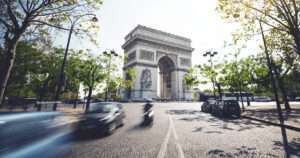Today, more and more mobility hubs are appearing in urban landscapes. These strategic hubs bring together different modes of transport for users to share. The aim of these mobility hubs is to considerably optimize the lives of residents, while promoting accessibility and inclusiveness. Recently, the city of Manchester launched work to build the country’s very first hub. This almost £30 million project aims to make neighborhood life more pleasant, by reducing traffic and parking. Find out more about the city’s promises on this ground-breaking project…
The ambition to change the mobility of an entire district
Although the project was approved in June 2021, it is only two years later that construction will begin. Manchester City Council had given the go-ahead for the development of a mobility hub in the Ancoats district. This hub is now scheduled for 2024. Its aim is to reduce emissions and traffic in the area. It will feature a multi-storey parking lot with parking capacity for 406 cars, 150 bicycles and 30 spaces for car-sharing and car-pooling. There will also be 102 recharging points for electric vehicles. The main objective is to reduce the space dedicated to parking. This space will also be used to develop community zones and public spaces in the neighborhood.
People-first, a new approach for urban planners
This project is part of the “people-first” movement. It is designed to put residents’ needs first. The hub promotes sustainable modes of transport while reducing traffic in the neighborhood. It should have a considerable impact on life in the surrounding area, even going so far as to offer alternative solutions to deliveries. Indeed, the hub will be equipped with a delivery center enabling residents to pick up their parcels or have them delivered to their homes by electric van or cargo bike.
The Ancoats mobility hub is designed by architects Buttress and Planit-IE, who aim to discourage the use of on-street parking and free up space for public open spaces, cycle paths and footpaths. With its focus on electric vehicle charging, the mobility center will help accelerate the transition to low-emission vehicles and improve air quality.
A project part of a global trend
This almost £30 million project will not stop at its own impact. On the contrary, it will be a springboard for other projects along the same lines. First and foremost, it will enable the delivery of 1,500 new homes in this part of Manchester. These include a project by This City, a housing development company, to deliver 128 new low-emission homes.
This Ancoats project represents an example of urban transformation focused on creating an inclusive neighborhood where residents come first. This mobility hub is also seen as a model for future investments in the city center, contributing to Ancoats’ reputation as a sustainable, low-carbon neighborhood.
A real solution, or just a marketing campaign by Manchester?
The enthusiasm displayed by Manchester’s authorities and local players needs to be tempered. Not everyone seems convinced by this solution, which has been heralded as a miracle. Many Internet users are ironic about it, seeing it as just another car park.
What’s so revolutionary about building a parking lot with solar panels?
Anonymous
Can you imagine mobility hubs connecting several modes together? No streetcar, bus or bike rentals (from what I’ve seen). It’s a glorified parking lot, albeit a nicer one with a few bike stores – if we really prioritize active travel, there should be an equal number of bike and car parking spaces.
Anonymous
“Mobility Hub”? Is that what they call multi-storey parking lots these days?
Anonymous
Let’s not forget the negativity bias to which the Internet exposes us, and let’s not be as critical as Internet users. While some people see it as nothing more than a new-generation parking lot, the authorities seem to see these mobility hubs as a real solution for the future of a more sustainable and connected city. And for you, revolution or future failure?
Looks like it will have some benefits. Cars off streets for one. Leading to better designed neighborhood. Safer, more attractive environment. It’s an efficient way of storing cars. We might not like them but try banning them. Won’t work.
Anonymous
Even if it were just a parking lot, it would free up space in the area that would have been used for on-street parking and allow many trips to the city center in an area with zero public transport coverage.
Anonymous





